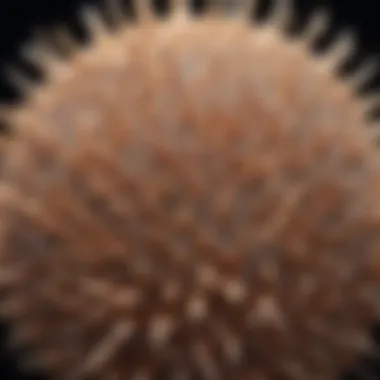Exploring the Fascinating Diversity of Hair Loss: An In-Depth Guide


Fashion Trends and Must-Have Pieces
Hair loss can impact individuals in various ways, transcending mere aesthetics and diving into the realm of health and self-esteem. Understanding the different types of hair loss is vital to navigate potential causes, symptoms, and management strategies effectively. From common conditions to rare disorders, the complexities of hair loss shed light on a prevalent issue that requires in-depth exploration.
Common Conditions Versus Rare Disorders
When delving into the world of hair loss, it becomes evident that some conditions are more prevalent, such as male pattern baldness or alopecia areata, while others, like trichotillomania or frontal fibrosing alopecia, are rarer but equally significant. Recognizing the distinctions between common and rare forms of hair loss is essential for accurate diagnosis and suitable treatment.
It is crucial to consult professional dermatologists or trichologists to assess individual cases of hair loss accurately and devise personalized management plans.
Identifying Causes and Symptoms
Unraveling the underlying causes of hair loss encompasses a spectrum of factors, ranging from genetic predisposition and hormonal imbalances to nutritional deficiencies and autoimmune conditions. Recognizing the early symptoms, such as gradual thinning, sudden bald patches, or excessive shedding, can prompt timely intervention and prevent further progression.
- Genetic Predisposition: *Family history plays a significant role in determining the likelihood of hereditary hair loss.
- Hormonal Imbalances: *Fluctuations in hormones, particularly dihydrotestosterone (DHT), can trigger patterned baldness in both men and women.
- Nutritional Deficiencies: *Inadequate intake of essential nutrients like iron, vitamins, and proteins can compromise hair growth and lead to thinning.
Implementing Management Strategies
Effective management of different types of hair loss demands a multifaceted approach that addresses underlying causes, mitigates symptoms, and promotes regrowth. Incorporating lifestyle modifications, nourishing haircare routines, and targeted therapies can significantly improve the prognosis and restore hair health.
- Lifestyle Modifications: *Adopting a balanced diet, managing stress levels, and avoiding harsh styling practices can bolster hair follicle health.
- Nourishing Haircare Routines: *Using mild shampoos, conditioning treatments, and scalp massages can enhance circulation and stimulate growth.
- Targeted Therapies: *Topical minoxidil, oral finasteride, PRP injections, or scalp micropigmentation are among the advanced treatments available to combat hair loss.
In essence, exploring the diverse types of hair loss unveils a complex interplay of factors that influence both prevalence and presentation. By gaining a comprehensive understanding of these intricacies, individuals can empower themselves to address hair loss proactively and embark on a journey towards revitalized hair health.
Prelude
Hair loss is a prevalent concern that impacts individuals of all ages and genders. Understanding the various types of hair loss is essential for grasping the complexities associated with this common issue. By dissecting the roots of hair loss, we can unravel the underlying reasons and potential solutions that may aid in addressing this intricate phenomenon.
Understanding Hair Loss
An Overview of Hair Loss
In the realm of hair loss, an overview serves as a foundational element, providing insights into the broad spectrum of factors that contribute to this condition. By delving into the nuances of hair loss patterns and triggers, readers can cultivate a deeper appreciation for the multifaceted nature of this challenge. The overview sets the stage for a comprehensive exploration of the diverse forms of hair loss, shedding light on both common conditions and rare disorders.
The Significance of Healthy Hair
Healthy hair serves as a visible indicator of overall well-being and vitality. Understanding the importance of maintaining healthy hair underscores the significance of holistic wellness. Healthy hair not only enhances one's physical appearance but also acts as a barometer of one's internal health. By emphasizing the essential role of healthy hair, individuals can adopt preventive measures and proactive strategies to preserve their hair quality and scalp condition.
Common Types of Hair Loss
Exploring common types of hair loss is essential in understanding the breadth of hair-related conditions individuals may encounter. By delving into Androgenetic Alopecia, Telogen Effluvium, and Alopecia Areata, we unravel the intricacies of these prevalent issues that impact individuals globally.
Androgenetic Alopecia


Causes and Risk Factors:
In Androgenetic Alopecia, the leading cause resides in genetic predisposition and hormonal imbalances. This contributes significantly to the gradual thinning of hair follicles over time, leading to visible hair loss. The interplay between genetics and androgens presents Androgenetic Alopecia as a quintessential topic for this article, shedding light on its substantial role in the spectrum of hair loss.
Symptoms and Progression:
The onset of Androgenetic Alopecia often manifests as a receding hairline or thinning at the crown of the head. Progression may vary among individuals, with some experiencing rapid hair loss, while others undergo a more gradual deterioration. Understanding the nuances of symptoms and progression is paramount in grasping the full impact of Androgenetic Alopecia within the realm of hair loss.
Treatment Options:
Various treatment options exist for Androgenetic Alopecia, including topical minoxidil, oral finasteride, and surgical interventions like hair transplants. Each approach carries its unique advantages and limitations, influencing the decisions individuals make regarding their management strategies. Through an exploration of treatment options, readers can discern the most suitable path to address Androgenetic Alopecia effectively.
Telogen Effluvium
Triggering Factors:
Telogen Effluvium is often triggered by significant stressors, hormonal fluctuations, nutritional deficiencies, or adverse reactions to medications. Understanding these underlying factors is crucial in comprehending the triggers that provoke this form of temporary hair loss. By delving into the triggering factors, a holistic view of Telogen Effluvium emerges, enriching our knowledge base on this transient condition.
Symptoms and Duration:
Symptoms of Telogen Effluvium include increased hair shedding, noticeable thinning, and potential scalp sensitivity. The duration of this condition varies, with hair commonly regrowing within six months to a year after addressing the underlying trigger. Educating readers on the symptoms and duration aids in demystifying the course of Telogen Effluvium, offering clarity on its transient nature.
Management Techniques:
Effective management of Telogen Effluvium involves stress management, dietary adjustments, scalp care, and seeking medical advice when necessary. These techniques play a pivotal role in mitigating hair loss and promoting regrowth, providing individuals with actionable steps to address Telogen Effluvium's effects. By exploring management techniques, readers can empower themselves with practical solutions to navigate through this phase of hair loss.
Alopecia Areata
Autoimmune Nature:
Alopecia Areata stems from an autoimmune response where the immune system mistakenly targets hair follicles. This unique feature illustrates the intricate relationship between immunity and hair health, elevating Alopecia Areata's significance in the landscape of hair loss research. Understanding its autoimmune nature unveils the complexities of this condition, setting it apart from other forms of hair loss.
Patterns of Hair Loss:
Hair loss in Alopecia Areata occurs in distinct, often round patches on the scalp or other areas with hair. These patterns of hair loss exhibit a characteristic presentation that aids in diagnosing the condition accurately. Exploring the patterns of hair loss enhances our ability to recognize and differentiate Alopecia Areata from other alopecia types, reinforcing the need for individualized therapeutic approaches.
Therapeutic Approaches:
Therapeutic approaches for Alopecia Areata encompass topical immunotherapy, corticosteroid injections, and systemic treatments to modulate immune responses. These varied approaches cater to the diverse presentations and severity of Alopecia Areata, offering patients a spectrum of options to manage their condition effectively. Engaging with therapeutic approaches equips readers with insights into potential treatments, guiding them towards informed decisions in addressing Alopecia Areata.
Lesser-Known Forms of Hair Loss
NestLED discreetly between well-known hair loss conditions lurks the realm of Lesser-Known Forms of Hair Loss, an intriguing domain often overshadowed by its more popular counterparts. In the narrative tapestry of this article, delving into these less-charted territories offers a unique perspective on hair loss. Exploring these lesser-known forms sheds light on their complexities and significance. The inclusion of such topics not only enriches the discourse but also provides a holistic view of the diverse spectrum of hair afflictions.


Trichotillomania
Psychological Roots
Trichotillomania, with its deep-seated Psychological Roots, presents a captivating angle in the intricate portrait of hair loss. The psychological underpinnings of this disorder unveil the intimate connection between mind and body. Revealing the underlying emotional triggers and compulsive nature, this section vividly illustrates how psychological factors intertwine with physical manifestations. While unveiling the nuances of Trichotillomania, one acknowledges its subtle yet pervasive impact, fostering a profound comprehension of the condition's essence.
Behavioral Patterns
The elucidation of Behavioral Patterns in Trichotillomania serves as a gateway to unraveling the intricate tapestry of hair-pulling behavior. Exploring the recurring actions and responses uncovers crucial insights into the behavioral aspects, underscoring the challenging nature of this disorder. By dissecting these patterns, one gains a deeper understanding of the underlying mechanisms driving such behaviors, fostering empathy and awareness within the reader's realm.
Psychosocial Impacts
Traversing through the abyss of Psychosocial Impacts engendered by Trichotillomania unveils a poignant narrative of the interplay between mental health and external influences. Delving into the far-reaching consequences on one's social and emotional well-being, this section sheds light on the profound effects of Trichotillomania. By exploring the psychosocial ramifications, one navigates the intricate web of challenges faced by individuals grappling with this condition, fostering empathy and enlightenment within the readership.
Understanding the intricate interplay of psychological, behavioral, and social aspects is imperative in comprehending the holistic impact of Trichotillomania.
Rare and Genetic Causes of Hair Loss
In this section, we delve into the intricate realm of rare and genetic causes of hair loss, shedding light on conditions that may not be as widely known but are crucial to understanding the complexity of this issue. By focusing on these specific elements, readers can deepen their knowledge and grasp the unique considerations associated with rare and genetic causes of hair loss.
Hypotrichosis
Genetic Origins
Exploring the genetic origins of hypotrichosis unveils a fundamental aspect of this condition, elucidating how genetic factors play a pivotal role in hair loss. Understanding the key characteristic of genetic origins provides valuable insights into the hereditary nature of hypotrichosis and why it is a significant inclusion in this comprehensive guide. The unique feature of genetic origins lies in its ability to offer a genetic perspective on hair loss, highlighting the interplay between genetics and hair health.
Types of Hypotrichosis
Diving into the types of hypotrichosis enriches our comprehension of the various forms this condition can manifest. Highlighting the key characteristic of different types of hypotrichosis underscores the diversity within this category and why it is essential to address these variations in this article. Describing the unique features of each type of hypotrichosis sheds light on the nuances in symptoms and progression, providing a nuanced understanding of this complex condition.
Therapeutic Options
Exploring the therapeutic options for hypotrichosis unravels possible treatment avenues to manage this condition effectively. Highlighting the key characteristic of various therapeutic options showcases the diversity in approaches available for individuals experiencing hypotrichosis and why discussing treatment modalities is paramount in this context. Describing the unique features of different treatment options offers readers a comprehensive view of the available interventions, including their advantages and potential drawbacks in addressing hypotrichosis.
Diagnosis and Treatment Approaches
Hair loss, a distressing condition affecting many individuals, necessitates a detailed examination towards effective management and potential restoration solutions. This section delves into the crucial aspect of Diagnosis and Treatment Approaches, shedding light on essential elements and considerations for combating hair loss.
Consulting a Dermatologist
Regardless of age or gender, seeking professional dermatological assistance can significantly impact diagnosing and treating hair loss effectively. Dermatologists play a pivotal role in crafting personalized solutions for individuals grappling with hair loss, ensuring a tailored approach to each case.
Diagnostic Procedures


- Diagnostic procedures form the backbone of addressing hair loss concerns, enabling dermatologists to identify underlying causes with precision. These procedures encompass scalp examinations, blood tests, and even microscopic analysis of hair samples to pinpoint specific issues.
- The meticulous nature of diagnostic procedures underscores their importance in unveiling the root causes of hair loss. By employing these precise methods, dermatologists can devise accurate treatment plans, streamlining the process towards optimum results.
Treatment Plans
- Tailored treatment plans curated by dermatologists cater to individual needs, incorporating a blend of medications, lifestyle adjustments, and potential interventions like hair transplants. These plans prioritize long-term hair health and restoration, aiming to address primary causes effectively.
- The personalized nature of treatment plans ensures a holistic approach towards combating hair loss, taking into account factors like genetic predispositions, lifestyle habits, and overall health indicators. Dermatologists navigate treatment options with finesse, promoting sustainable hair regrowth and vitality.
Follow-Up Care
- Post-treatment follow-up care emerges as a critical phase in monitoring progress and fine-tuning treatment regimens. Regular consultations with dermatologists allow for adjustments based on individual responses, ensuring a comprehensive and evolving approach to battling hair loss.
- The vigilant oversight in follow-up care empowers individuals to stay proactive in their hair health journey, fostering a collaborative relationship with healthcare providers. Through consistent monitoring and guidance, potential setbacks can be addressed promptly, enhancing the efficacy of treatment plans.
Innovations in Hair Restoration
As advancements in medical technologies continue to revolutionize the field of dermatology, innovative solutions for hair restoration offer renewed hope for individuals grappling with hair loss.
Surgical Techniques
- Surgical techniques such as hair transplantation present a transformative option for permanent hair restoration, utilizing advanced procedures to relocate healthy follicles to areas experiencing balding. These techniques require precision and expertise, delivering natural-looking results for enhanced confidence.
- The intricate nature of surgical techniques underscores their effectiveness in addressing extensive hair loss cases, providing individuals with a lasting solution that mirrors the natural growth pattern of hair. Consultations with skilled surgeons ensure informed decisions and optimal outcomes.
Non-Invasive Procedures
- Non-invasive procedures offer minimally disruptive alternatives to surgical interventions, catering to individuals seeking less invasive options for hair restoration. Treatments like laser therapy and platelet-rich plasma injections promote hair regrowth without the need for extensive downtime.
- The rising popularity of non-invasive procedures reflects a growing demand for non-surgical solutions in the realm of hair restoration. These treatments boast shorter recovery periods and reduced risks, making them appealing choices for individuals exploring diverse rejuvenation avenues.
Future Trends
- Exploring emerging trends in hair restoration unveils promising techniques like stem cell therapy and gene editing, heralding a future where genetic hair loss could be reversed at a cellular level. Research endeavors continually push boundaries, offering innovative strategies for sustainable hair regeneration.
- The anticipation surrounding future trends in hair restoration underscores a proactive shift towards transformative solutions that address hair loss at its core. Stay abreast of evolving technologies and research developments to harness cutting-edge treatments for optimal hair rejuvenation.
Lifestyle Modifications
Embracing holistic lifestyle modifications forms a cornerstone in nurturing healthy hair growth and resilience, complementing professional interventions for comprehensive care.
Dietary Considerations
- Diets rich in essential nutrients like vitamins, minerals, and proteins play a pivotal role in fortifying hair follicles and promoting growth. Incorporate foods like fish, nuts, seeds, and leafy greens to optimize hair health from within, fostering a robust foundation for hair regeneration.
- Stress Management
- Effective stress management techniques like mindfulness practices, yoga, and adequate sleep regulate hormone levels, preventing stress-induced hair loss. Prioritize self-care strategies to reduce tension and anxiety, safeguarding hair health amidst demanding lifestyles.
- Scalp Care Practices
- Routine scalp care routines involving gentle massage, proper cleansing, and hydrating treatments maintain scalp circulation and vitality. Choosing scalp-friendly hair products and minimizing heat styling aids in preserving hair quality, nurturing a conducive environment for regrowth.
Finale
Hair loss is not merely a cosmetic concern; it can significantly impact one's self-esteem and quality of life. Understanding the various types of hair loss is the first step towards effective management and treatment. By delving into the complexities of different conditions, individuals can make informed decisions about their hair health. This article has provided a comprehensive overview of common and rare forms of hair loss, empowering readers with knowledge to take proactive steps in addressing this prevalent issue.
Empowerment through Knowledge
Taking Control of Hair Health:
Taking control of hair health involves adopting a holistic approach towards maintaining a healthy scalp and hair. By focusing on nourishing the scalp, choosing suitable hair care products, and addressing underlying health conditions, individuals can promote optimal hair growth and minimize hair loss. This proactive stance not only enhances hair health but also boosts overall well-being and confidence.
Embracing Individuality:
Embracing individuality in the context of hair loss acknowledges that each person's experience with this issue is unique. Whether opting for natural remedies, seeking medical intervention, or embracing baldness without reservation, embracing one's individuality in managing hair loss allows for a personalized and empowering journey towards hair health.
Community Support:
Community support plays a vital role in navigating the emotional and practical challenges of dealing with hair loss. Engaging with support groups, seeking advice from professionals, and sharing experiences with others facing similar struggles can provide comfort, guidance, and a sense of belonging. This communal support fosters a supportive environment for individuals coping with hair loss, promoting resilience and empowerment.







